written by Laurie Tom
Fall is well under way and the new anime debuted in October. As usual I watched the first episode of each to decide which series I would like to follow this season.
Because of the new streaming partnership between Funimation and Crunchyroll, this fall is unusual in that everything I watch is now on Crunchyroll since I prefer subtitles. Those who prefer dubs can still find those streaming on Funimation, if a dubbed version exists, but neither site has an exclusive on a particular show anymore now that they’re sharing all new simulcast licenses acquired by either company.
I’m still amazed that such a thing as simulcast dubbing exists. Funimation’s schedule runs about 2-3 weeks behind the Japanese broadcast.
Bloodivores
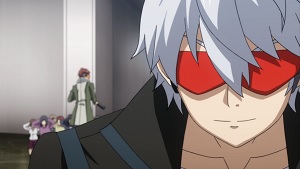
Why I Watched It: Normally I would pass on yet another take on vampires (it seems the rest of the world is just as crazy about them as Americans), but this series is based on a Chinese web comic, and the Japanese rarely do a direct adaptation of work from another country, so I figured this is probably something special.
What I Thought: Bloodivores, dopey title aside, is a little rough around the edges. It does places its own spin on vampires by making their condition an unexpected (and apparently permanent) side effect of a medication intended to suppress a disease, but doesn’t really dig into the world building on how bloodivores and normal humans coexist. The main plot doesn’t show until about halfway through, when protagonist Mi Liu and his bloodivore friends are framed for the murder for fifteen people, by which time the plot gets busy, fitting in a lot of father-son angst over a missing mother, and setting up a cliffhanger.
Verdict: I’m probably going to pass. I’m still a little curious, and it’s possible to see the Chinese origin in subtle ways aside from character names, but the series doesn’t seem that interested in world building and the next episode looks it takes a (very random) hard left turn into Hunger Games territory, with monsters.
Where to find stream: Crunchyroll
Izetta: The Last Witch
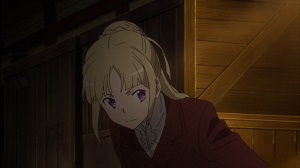
Why I Watched It: I jumped back and forth on whether to watch this one because of the World War II setting. Though I like it, I feel burnt out on the time period. Then I found out the series is set in an WW2 analog rather than the real world, and I was afraid it would trivialize all the problems surrounding the war, especially with how bright and colorful the promo art was of the titular witch. But finally word of mouth convinced me to give it a shot.
What I Thought: Izetta doesn’t bother to hide that its fictional world is based on WW2, as the first episode even has a WW2-era map showing the Germania Empire’s blitzkreig into Livonia (Poland) and subsequent subduing of Thermidor (France) with Brittania remaining as its primary enemy. The story follows Princess Finé of the fictional Duchy of Eylstadt, located in the eastern third of what would be Austria and she’s one of the more capable heroines in anime as there isn’t a love interest in sight as she and her bodyguards evade enemy agents on a well choreographed train sequence. The bad guys are mostly stereotypical Nazi stand-ins, which is disappointing since I want the 1940s-style time period to be more than set dressing.
Verdict: I might watch this one, time permitting. I do like Finé and, with the titular Izetta showing up at the end of the episode, I like the idea of two girls against an empire, but this time period has been so done to death that I need more complexity from both sides of the conflict.
Where to find stream: Crunchyroll (subtitled) and Funimation (dubbed, subscription required)
March Comes in Like a Lion
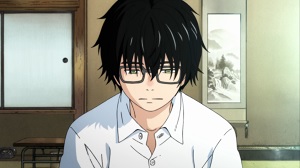
Why I Watched It: I don’t know how to play shogi, but one of the fun things about anime is that they can make a series about anything and people will watch if it’s interesting. March Comes in Like a Lion was one of the highest anticipated titles coming into the season due to its manga pedigree.
What I Thought: I’m really not certain why it’s so well regarded, at least from the opening episode. There’s some interesting imagery where Rei’s thoughts seem to be mirrored through the use of water, but there’s a lot of mood whiplash which makes me wonder what kind of story it’s supposed to be. The opening nine minutes are so tense that Rei doesn’t even speak. Then the atmosphere takes a comical turn when we meet a bunch of girls who appear to be family friends, only for the mood to reverse again when he hears about someone getting beaten to death on the news. It’s implied he knows the person, but much like his relationship to the girls, how he knows them isn’t spelled out. The episode finally ends with someone who looks like a wannabe rival showing up and taunting him like he came out of a kid’s show.
Verdict: I’m going to pass. I have no idea where it’s going, and while the opening nine minutes were a great exercise showing Rei’s isolation and ability to play shogi, rest of the episode just doesn’t hold up.
Where to find stream: Crunchyroll and Daisuki
Natsume Yujin-cho 5
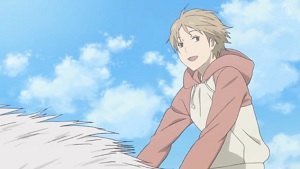
Why I Watched It: I’d previously reviewed the first four seasons of Natsume’s Book of Friends (the translated title used for the home video release) and expected that would be the end of the series. But four years later the series about a good-natured teenage boy who can see spirits has been revived for a fifth go around. It’s being animated by a different studio, but all the original cast is back as well as some of the production team.
What I Thought: Despite the studio change, Natsume Yujin-Cho slips almost flawlessly back into the saddle. Once again Natsume is confronted with a problematic yokai whose issue with him is rooted in the history it has with his grandmother Reiko. It’s not going to convert anyone who doesn’t already like the series, but being episodic, it’s very easy for new viewers to slip into as the first few minutes quickly bring everyone up to speed on his ability to see yokai and his isolation from other humans because of it.
Verdict: I’ll be watching. It’s not really a binging type of series, but with the previous series each episode was a great little pick-me-up whenever I wanted something low key and sweet.
Where to find stream: Crunchyroll
Poco’s Udon World
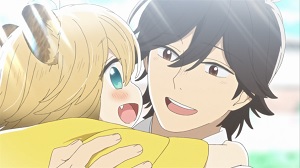
Why I Watched It: A lot of Japanese storytelling has no issue mixing the spirit world with the mundane. It’s one of the fun things that I don’t get with a lot of western material. Poco’s Udon World follows that tradition with a story about a 30-year-old man who discovers a childlike fox spirit when he goes home to inherit the family business.
What I Thought: Better than I thought! When Souta Tawara goes home to rural Kagawa Prefecture it’s to clean out the family home so it can be sold after the proper mourning period. His father’s udon restaurant is closed, but people keep wanting him to open it up again and we get to see snippets of his childhood from when he wanted to be just his like dad to a young adult where he says the last thing he wants is to take over the restaurant. The tanuki (not a fox!) keeps things from staying too melancholy, but it feels like this is very much Souta’s story about finding what he really wants, and I hope it stays that way.
Verdict: I’ll be watching. I find Souta easily relatable and the tanuki (presumably to be named Poco later) is surprisingly cute without being annoying. This is important because the tanuki spends most of its screen time with the appearance as a human toddler with a limited vocabulary.
Where to find stream: Crunchyroll
Trickster
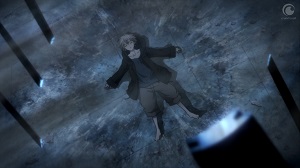
Why I Watched It: After the mixed result that was Rampo Kitan, I continued to see mystery writer Rampo Edogawa’s name cropping up in various places. He’s had a huge effect on the Japanese mystery genre. Unfortunately little of his work is available in English, so when I saw a new project based on his Kogoro Akechi stories was launched I figured I’d give it a shot.
What I Thought: Trickster feels like an odd throwback to the 90s, with its sort of near future science fiction setting and especially with its confident and relentlessly upbeat protagonist, Hanasaki. He’s probably not going to be a deep character, but that’s okay since he has an ensemble cast with him. Worth mentioning, though not in a positive way, is Kobayashi, a immortal boy who does have powers and wants to die (badly). The most grating part of the first episode is listening to Kobayashi whine about how he wants to die but can’t. It might have meaning later, but his half-hearted attempts to kill himself come off as rather pathetic than character building.
Verdict: I might watch this one. It depends on how much Kobayashi ends up annoying me and how much Hanasaki can make up for it. (There might be something about the original Kobayashi from Edogawa’s fiction, since I disliked the Rampo Kitan version too.)
Where to find stream: Crunchyroll
Yuri on Ice
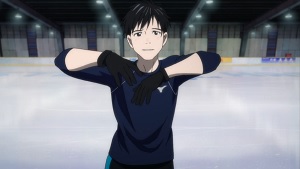
Why I Watched It: I was completely sold by the trailer. I’d seen some nicely animated ice skating in Death Parade, but Yuri on Ice‘s animation is just gorgeous. The movement is fluid and realistic, and I think it’s telling that they hired an Olympic choreographer to work on the routines for the different skaters.
What I Thought: You can really see the homework the animation team did on the skating sequences, and fortunately Yuri on Ice isn’t just about its looks. The story follows figure skater Yuri Katsuki who at 23 is already fading from the international stage. He’s a relatable protagonist, having feelings of inadequacy, inability to focus, and even dealing with weight issues (which is incredibly rare for a male character). Of course all that is set to change when a friend’s kid uploads a video of him beat-for-beat copying the reigning world champion’s routine in a private skate, and the world champion himself shows up at Yuri’s door to be his new coach.
Verdict: I’ll be watching. I’m a fan of figure skating in general and Yuri so easy to root for that I want to see his journey.
Where to find stream: Crunchyroll (subtitled) and Funimation (dubbed, subscription required)
Conspicuously missing:
The Great Passage – Based on a bestselling novel about a salesman who gets recruited into his company’s dictionary editing project. Since The Great Passage is a Noitamina production it should be covered by the exclusivity agreement it has with Amazon, but it’s only streaming in Amazon UK, and not in the United States. Dictionary editing probably sounds like a very boring premise for a series, which I suspect is the reason Amazon is not simulcasting this, which is a shame since early impressions from outside the US are good.

Laurie Tom is a fantasy and science fiction writer based in southern California. Since she was a kid she has considered books, video games, and anime in roughly equal portions to be her primary source of entertainment. Laurie is a previous grand prize winner of Writers of the Future and since then her work has been published in Galaxy’s Edge, Strange Horizons, and the Year’s Best YA Speculative Fiction.

 Shovel Knight is an 8-bit styled platformer action game published by Yacht Club Games in 2014.
Shovel Knight is an 8-bit styled platformer action game published by Yacht Club Games in 2014.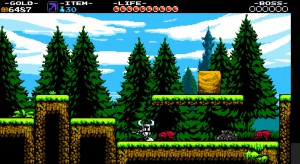
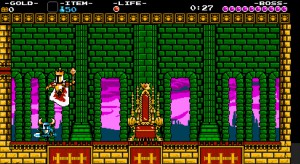 The levels are longish and progress is lost if you quite the game while you’re in the middle of one, so it’s best to have a little longer stretch if you want to sit down and play the game. But the levels do have checkpoints that help make the levels easier to progress through if you need them. Each level is very different in style and contains very different enemies, which nicely keeps the game fresh throughout the playtime. Each boss requires you to learn his patterns to be able to avoid and find opportunities to attack. The game is reasonably challenging and if you want to make it more challenging there are ways to ramp it up, such as avoiding collecting the magic weapon items, breaking checkpoints to make extra money instead of using them as checkpoints, avoiding health meter enhancing items, etc.
The levels are longish and progress is lost if you quite the game while you’re in the middle of one, so it’s best to have a little longer stretch if you want to sit down and play the game. But the levels do have checkpoints that help make the levels easier to progress through if you need them. Each level is very different in style and contains very different enemies, which nicely keeps the game fresh throughout the playtime. Each boss requires you to learn his patterns to be able to avoid and find opportunities to attack. The game is reasonably challenging and if you want to make it more challenging there are ways to ramp it up, such as avoiding collecting the magic weapon items, breaking checkpoints to make extra money instead of using them as checkpoints, avoiding health meter enhancing items, etc.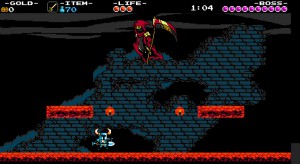 Challenge
Challenge The Last Town is a… I guess I’d call it an SF/horror thriller… the final book in a trilogy written by Blake Crouch and published in 2014 by Thomas & Mercer. There’s no way to discuss the events of this book without major spoilers for the first two books, so if you don’t want to know anything about book 1 and book 2, stop here. I have reviewed
The Last Town is a… I guess I’d call it an SF/horror thriller… the final book in a trilogy written by Blake Crouch and published in 2014 by Thomas & Mercer. There’s no way to discuss the events of this book without major spoilers for the first two books, so if you don’t want to know anything about book 1 and book 2, stop here. I have reviewed  Wayward is a… I guess I’d call it a mystery SF thriller… the second of a trilogy written by Blake Crouch and published in 2013 by Thomas & Mercer.
Wayward is a… I guess I’d call it a mystery SF thriller… the second of a trilogy written by Blake Crouch and published in 2013 by Thomas & Mercer. Pines is a… I guess I’d call it a mystery fantasy/SF thriller… the first of a trilogy written franchise tie-in novel written by Blake Crouch and published in 2012 by Thomas & Mercer.
Pines is a… I guess I’d call it a mystery fantasy/SF thriller… the first of a trilogy written franchise tie-in novel written by Blake Crouch and published in 2012 by Thomas & Mercer.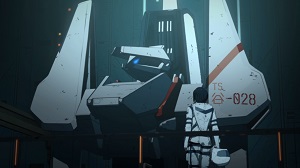
 What We Do in the Shadows is a mockumentary horror comedy film which had a theatrical release in 2014. It was directed by Jemaine Clement (who you might know as half of New Zealand’s fourth most popular folk comedy duo Flight of the Conchords) and Taika Watit, who also both acted in the film. The film is structured as a documentary following four vampires who are flatmates in New Zealand, chronicling their everyday lives including flatmate disputes, their feeding habits, their human familiar, their night life, and avoiding vampire hunters.
What We Do in the Shadows is a mockumentary horror comedy film which had a theatrical release in 2014. It was directed by Jemaine Clement (who you might know as half of New Zealand’s fourth most popular folk comedy duo Flight of the Conchords) and Taika Watit, who also both acted in the film. The film is structured as a documentary following four vampires who are flatmates in New Zealand, chronicling their everyday lives including flatmate disputes, their feeding habits, their human familiar, their night life, and avoiding vampire hunters.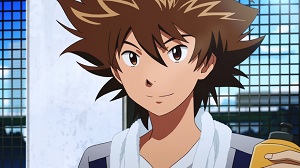 I did not grow up with Digimon in that I had just graduated college when it started airing, but it was one of the last series I watched as a Saturday morning cartoon. People who haven’t seen it tend to dismiss it as a Pokemon knock-off, for featuring young children with monster buddies, but it did something that Pokemon did not. It allowed its protagonists to mature and grow up.
I did not grow up with Digimon in that I had just graduated college when it started airing, but it was one of the last series I watched as a Saturday morning cartoon. People who haven’t seen it tend to dismiss it as a Pokemon knock-off, for featuring young children with monster buddies, but it did something that Pokemon did not. It allowed its protagonists to mature and grow up.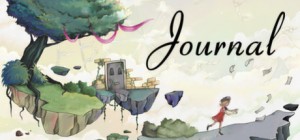
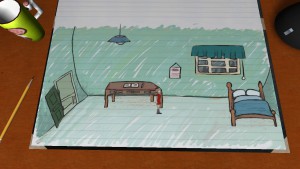 I thought the idea for this game was interesting. I liked how it didn’t go the straightforward After School Special route where if you do the right thing then everything will turn out happy for you. I thought the art was nice enough, and the voice acting good. I picked up on the sense that the narrative was kind of feeling around the empty spaces where other events in her life would be revealed to be, which I thought was an interesting technique.
I thought the idea for this game was interesting. I liked how it didn’t go the straightforward After School Special route where if you do the right thing then everything will turn out happy for you. I thought the art was nice enough, and the voice acting good. I picked up on the sense that the narrative was kind of feeling around the empty spaces where other events in her life would be revealed to be, which I thought was an interesting technique.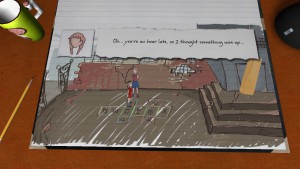 Visuals
Visuals